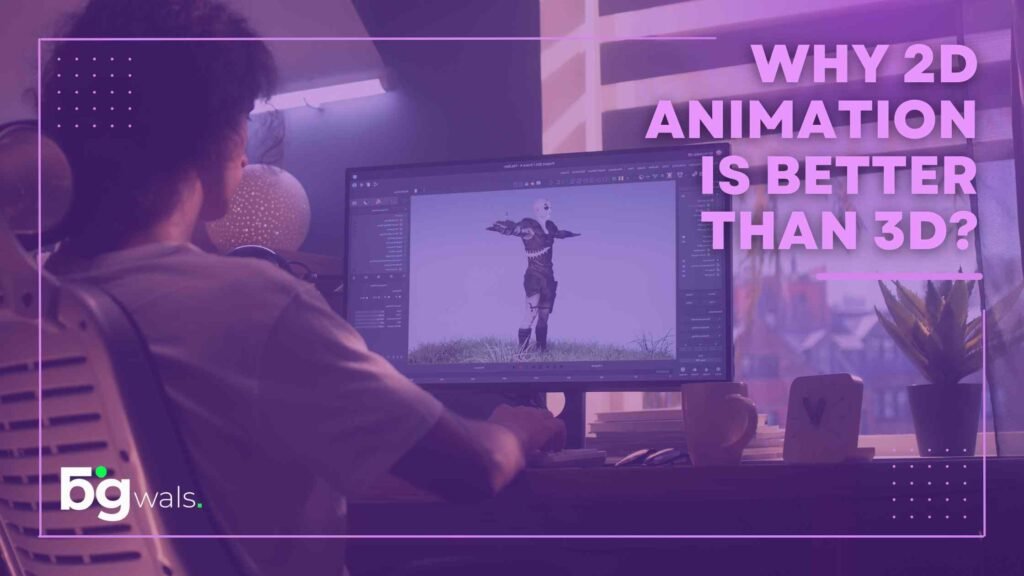In a world consumed by technological advancement and dazzling visual effects, the timeless art of animation often finds itself at a crossroads. While 3D animation has undeniably captured the hearts of many, there’s a hidden gem that continues to captivate a select group of aficionados—the world of 2D animation. This is not merely a debate of tradition versus innovation; it’s an exploration of the intricate aspects that make 2D animation stand tall and proud in a world dominated by 3D extravaganzas. So, let’s embark on this journey to unveil the hidden charms of 2D animation and why it’s often superior to its three-dimensional counterpart.
The Essence of Artistry
Our journey begins with the most elemental aspect—the essence of artistry. 2D animation, at its core, is a handcrafted masterpiece, a labor of love that thrives on the sheer creativity of its artists. Every frame is a brushstroke of emotion, every character a manifestation of imagination. The artists behind 2D animation breathe life into each character, frame by frame. Unlike 3D animation, which relies heavily on computer algorithms and automated processes, 2D animation remains a haven for artists to infuse their unique style and personality into every element.
Take, for example, Disney’s classics like “The Little Mermaid” or “The Lion King.” The artistry in these 2D animations can be felt through every line, every expression, and every stroke. The distinct styles of renowned animators, such as Glen Keane and Andreas Deja, shine through in every character they bring to life. The hand-drawn appeal of 2D animation creates a tangible connection between the viewer and the artistry, offering a level of emotional depth and authenticity that is often lacking in 3D animation.
Timelessness and Nostalgia
Nostalgia has a powerful hold over us, and 2D animation is a master at evoking this sentiment. The classics like “Snow White and the Seven Dwarfs” and “Cinderella” have a timeless quality, thanks to their 2D animation roots. These animations are cherished by generations and hold a special place in the hearts of those who grew up with them. The magic of 2D animation lies in its ability to transcend time, appealing to both young and old. It is a bridge between generations, uniting us with the stories and characters that have shaped our childhoods.
Even today, 2D animation continues to invoke nostalgia. Take, for instance, the enchanting world of Studio Ghibli, known for masterpieces like “Spirited Away” and “My Neighbor Totoro.” These films maintain the essence of traditional 2D animation, connecting with audiences on a profound level. The impact of these films is undeniable, creating a lasting emotional bond that 3D animation struggles to match.
Creativity and Expressiveness
In the realm of creativity and expressiveness, 2D animation stands as an unrivaled champion. It offers a unique canvas for artists to experiment, innovate, and push the boundaries of their imagination. The fluidity and versatility of 2D animation allow for dynamic character expressions, whimsical movements, and limitless possibilities. Whether it’s the exaggerated facial expressions of Looney Tunes characters or the surreal dreamscape of “Fantasia,” 2D animation invites us into a world of boundless creativity.
3D animation, while impressive in its own right, often operates within a more constrained framework. The rigidity of 3D character models and movements, while realistic, can sometimes lack the charm and spontaneity that 2D animation effortlessly delivers. For instance, the exaggerated humor in “Tom and Jerry” or the physical comedy in “The Pink Panther” relies on the freedom of 2D animation to transcend the boundaries of the physical world.
Artistic Expression Through Music
The harmonious relationship between 2D animation and music is one of the most mesmerizing aspects of this medium. Whether it’s the melodic notes of “Beauty and the Beast” or the rhythmic beats of “The Jungle Book,” 2D animation has an uncanny ability to blend music and visuals seamlessly. The synchronization of animated movements with the soundtrack creates a symphony of emotion that resonates deeply with the audience.
In contrast, 3D animation often struggles to capture the same level of synchronization. While it can certainly create stunning visuals and soundscapes, the connection between the two can sometimes feel disjointed. 2D animation’s fluidity allows for a more direct and intuitive connection between the music and the animation, making it a sublime medium for musical storytelling.
Simplicity and Intimacy
The power of simplicity cannot be overstated in the realm of storytelling. 2D animation excels in its ability to deliver complex narratives through simple, relatable characters and settings. Take “Winnie the Pooh” or “Peanuts” as prime examples. These beloved characters are effortlessly charming and relatable, making it easy for audiences to form a deep emotional bond with them. 2D animation excels in portraying the intricacies of human emotions and relationships through its straightforward yet profound approach.
On the other hand, 3D animation often leans towards grandeur and spectacle, with intricate details and complex 3D models. While this can be visually stunning, it can sometimes overshadow the intimacy and simplicity of the story. The relatability of 2D characters like Charlie Brown or Winnie the Pooh becomes a stark contrast to the highly detailed, yet often less approachable, characters in 3D animations.
The Flexibility of Visual Style
2D animation offers an incredible flexibility in visual style. Whether it’s the dark, gothic charm of Tim Burton’s “The Nightmare Before Christmas” or the vibrant, fantastical world of “Alice in Wonderland,” 2D animation can adapt to a wide range of visual aesthetics. This adaptability allows artists to tell a diverse array of stories, from the whimsical to the dark and eerie, with equal finesse.
In contrast, 3D animation often demands a certain level of uniformity in style due to the constraints of three-dimensional modeling. While it can excel in creating realistic worlds and characters, it might struggle to capture the same level of diversity and uniqueness that 2D animation effortlessly achieves.
Immersion and Depth of Storytelling
The immersion in a 2D animated world is a unique experience that 3D animation often finds challenging to replicate. The hand-drawn quality of 2D animation invites the audience to engage on a more profound level. It allows us to see the imperfections, the subtle nuances, and the artistic choices that give life to the characters and their surroundings.
The depth of storytelling in 2D animation is evident in films like “The Iron Giant” and “The Prince of Egypt.” These films manage to tackle complex themes and emotions, appealing to both children and adults alike. The sincerity of 2D animation invites viewers to connect with the story in a more intimate way, making it an ideal medium for thought-provoking narratives.
Cultivating Talent and Tradition
An often overlooked aspect is the preservation of artistic tradition. 2D animation has been a cornerstone of the animation industry for nearly a century, with a rich legacy of talent, techniques, and skills passed down through generations. The cultivation of traditional animation skills is an essential aspect of this medium.
While 3D animation has brought about its own innovations, it has also overshadowed some of the traditional skills that are integral to 2D animation, such as hand-drawn character animation. The continuous evolution and appreciation of 2D animation help maintain these valuable skills and ensure that future generations of animators have access to this wealth of knowledge.
Accessibility and Inclusivity
The accessibility and inclusivity of 2D animation are often underappreciated. 2D animation can be more cost-effective and less resource-intensive than 3D animation, making it a viable option for independent creators and small studios. This accessibility allows for a broader range of voices and stories to be told, contributing to a more diverse and inclusive animation landscape.
In contrast, 3D animation can require substantial financial and technological resources, which may limit the opportunities for emerging talent and underrepresented voices to break into the industry. The relatively lower entry barriers of 2D animation foster a more diverse and vibrant creative community.
The Charms of 2D Animation in a 3D World
In a world increasingly dominated by 3D animation, the charms of 2D animation remain a beacon of artistic integrity, timelessness, and emotional depth. It’s a medium that celebrates the essence of artistry, evokes nostalgia, and provides a canvas for limitless creativity. The synergy between music and visuals in 2D animation is unparalleled, and its simplicity and relatability make it a powerful storytelling tool.
The flexibility of visual styles, the immersion it offers, and the depth of storytelling make 2D animation a treasure trove of artistic potential. It preserves a rich tradition of animation skills and fosters inclusivity and accessibility for a diverse range of creators.
So, as we journey through the captivating world of 2D animation, let us not forget the treasures that lie hidden in its simplicity, authenticity, and artistry. In a world that often rushes past the beauty of the past, let us pause and celebrate the timeless allure of 2D animation.
The Endless Allure of 2D Animation
As we conclude our journey through the world of 2D animation, one cannot help but feel a sense of nostalgia and appreciation for this enduring art form. While 3D animation continues to dazzle us with its technological prowess, 2D animation stands as a testament to the timeless power of human creativity, storytelling, and artistry.
The charms of 2D animation are not merely a matter of preference but a celebration of the profound emotional connection it forges with its audience. It is a reminder that, in the quest for innovation and advancement, we should never lose sight of the hidden gems that have touched our hearts and shaped our world.
Conclusion
In the world of animation, small 2D animation studios are gaining recognition for their ability to offer cost-effective solutions to clients. These nimble, independent studios excel in preserving the essence of 2D animation while providing a range of services, including 2D logo animation. When it comes to 2D animation, the cost per minute is often more affordable compared to the resource-intensive demands of 3D animation. This affordability makes it an attractive choice for businesses, especially when they want to create engaging 2D logo animations that captivate their audience without breaking the bank.




1 thought on “Why 2D Animation Is Better Than 3D?”
Awesome! Its genuinely remarkable post, I have got much clear idea regarding from this post